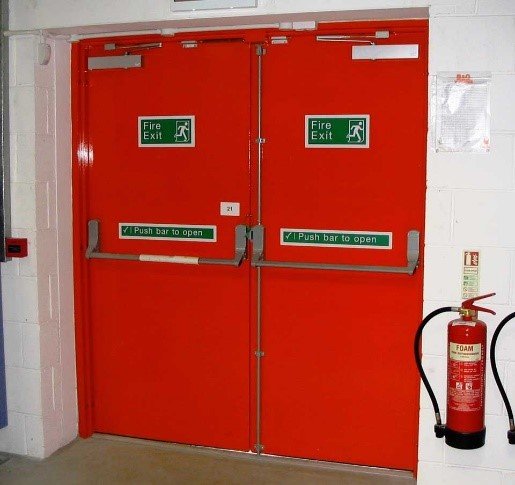

A fire and smoke door is what is known as a passive fire protection device. Passive fire protection uses different types of products that are built into the structure of the building (e.g. a fire door or fire wall) to help prevent the spread of fire.
When a building is designed, an architect will arrange the building on the basis of different types of compartments. Compartmentalisation is the most common form of passive fire protection. The idea is to divide a structure into “fire compartments”, which may contain single or multiple rooms, for the purpose of limiting the spread of fire, smoke and gases to other parts of a building. It is the same principle as the design of a ship, dividing the volume of the hull into watertight compartments so that if there is a breach, the water will be contained in that compartment only. Once the compartments have been designed, a fire door is then installed to complete the closure of the compartment.
You will find the use of fire doors in most buildings. They can range from the unit front door to the doors in the fire escapes.
Types of Fire Doors
There are generally two different types of fire doors used:
- Sole Occupancy Unit Fire Rating Level -/60/30: This type of fire door is a one hour rated fire door.
- Common Property Fire Door -/120/30: This type of fire door is a two hour rated fire door
The numbers refer to the following:
- Structural adequacy – How long the structure will support the load and remain vertical
- Integrity – How long the structure will inhibit flames
- Insulation – how long the structure will not increase in temperature
Therefore, for doors a rating of -/60/30 indicates the door will inhibit flames for 60 minutes and remain cool for 30. The dash (-) indicating structural adequacy means that the door is non load bearing however the fire door provides integrity and insulation protection.
The Building Code of Australia and local council legislation requires that fire doors be inspected and tested at the following intervals:
- 6 Monthly – Common Property Fire Doors
- Annual – Common Property Fire doors and Sole Occupancy Unit Fire Doors
For a fire door to be certified as being a fire door the following is required:
- Fire Rated Frame
- Approved Fire Rated Hardware
- Fire Rated Automatic Door Closer
- One Hour or Two Hour fire rated door certified according to the Australian Standards AS1905 and having the correct fire rating level.
FireSafe is able to install, repair and service all types of fire doors and provide certification for these fire doors according to the Australian Standards.
Fire Doors in Sydney – We’re the Experts
FireSafe is an expert provider of commercial, industrial and high-rise residential fire protection, inspection, installation, and maintenance and certification services. We offer an extensive range of scheduled testing as well as inspection services that are compliant with AS1851-2012 and the Building Code of Australia. We also provide fire equipment registers and reports that assist in the compilation of the Annual Fire Safety Statement specifically for building owners. These comprehensive documents form a crucial component of the compliance process for every property owner, with the BCA (Building Code of Australia), the OH&S Act as well as the Environmental Planning & Assessment Act 2000.
For a free fire safety and audit inspection, call FireSafe at 1300 347 372. You can also send us your queries via this online form.
